Research: Additive Manufacturing Impact on Business Model Innovation
VerifiedAdded on 2023/06/07
|12
|2478
|340
Project
AI Summary
This research project explores the transformative impact of additive manufacturing on business model innovation within the manufacturing industry, focusing on its evolution from prototyping to potential home fabrication. The study investigates the factors driving the growth of additive manufacturing and the changes in business models, employing a mixed-methods approach with both quantitative (online surveys) and qualitative (interviews) data collection. Statistical analysis and coding techniques are used to analyze the collected data, and the research considers ethical implications, reliability, and validity. The expected results highlight the association between additive manufacturing and business model innovation, providing insights into the future of home fabrication and its implications for the manufacturing sector. Desklib offers a wealth of similar resources for students.
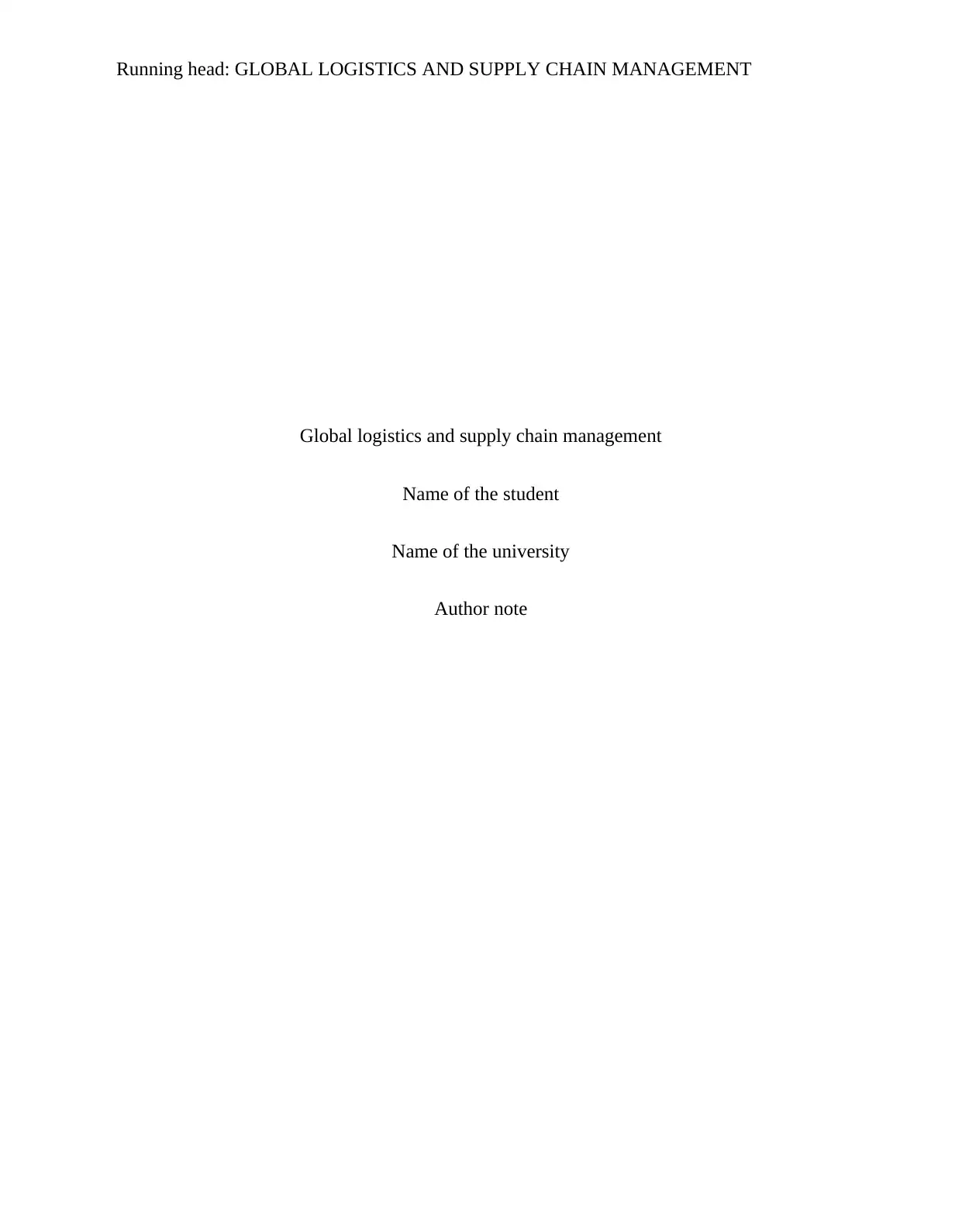
Running head: GLOBAL LOGISTICS AND SUPPLY CHAIN MANAGEMENT
Global logistics and supply chain management
Name of the student
Name of the university
Author note
Global logistics and supply chain management
Name of the student
Name of the university
Author note
Paraphrase This Document
Need a fresh take? Get an instant paraphrase of this document with our AI Paraphraser
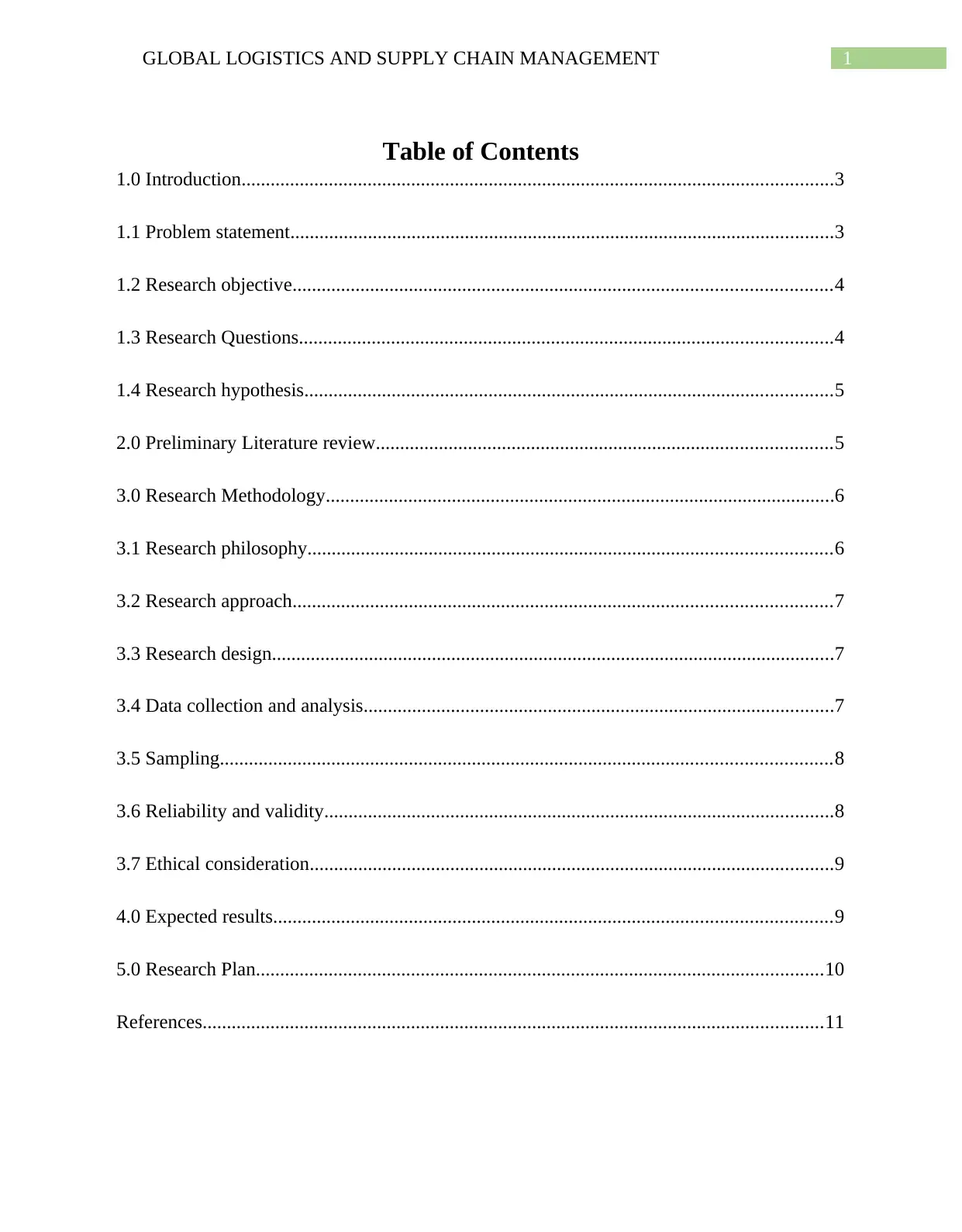
1GLOBAL LOGISTICS AND SUPPLY CHAIN MANAGEMENT
Table of Contents
1.0 Introduction..........................................................................................................................3
1.1 Problem statement................................................................................................................3
1.2 Research objective...............................................................................................................4
1.3 Research Questions..............................................................................................................4
1.4 Research hypothesis.............................................................................................................5
2.0 Preliminary Literature review..............................................................................................5
3.0 Research Methodology.........................................................................................................6
3.1 Research philosophy............................................................................................................6
3.2 Research approach...............................................................................................................7
3.3 Research design....................................................................................................................7
3.4 Data collection and analysis.................................................................................................7
3.5 Sampling..............................................................................................................................8
3.6 Reliability and validity.........................................................................................................8
3.7 Ethical consideration............................................................................................................9
4.0 Expected results...................................................................................................................9
5.0 Research Plan.....................................................................................................................10
References................................................................................................................................11
Table of Contents
1.0 Introduction..........................................................................................................................3
1.1 Problem statement................................................................................................................3
1.2 Research objective...............................................................................................................4
1.3 Research Questions..............................................................................................................4
1.4 Research hypothesis.............................................................................................................5
2.0 Preliminary Literature review..............................................................................................5
3.0 Research Methodology.........................................................................................................6
3.1 Research philosophy............................................................................................................6
3.2 Research approach...............................................................................................................7
3.3 Research design....................................................................................................................7
3.4 Data collection and analysis.................................................................................................7
3.5 Sampling..............................................................................................................................8
3.6 Reliability and validity.........................................................................................................8
3.7 Ethical consideration............................................................................................................9
4.0 Expected results...................................................................................................................9
5.0 Research Plan.....................................................................................................................10
References................................................................................................................................11
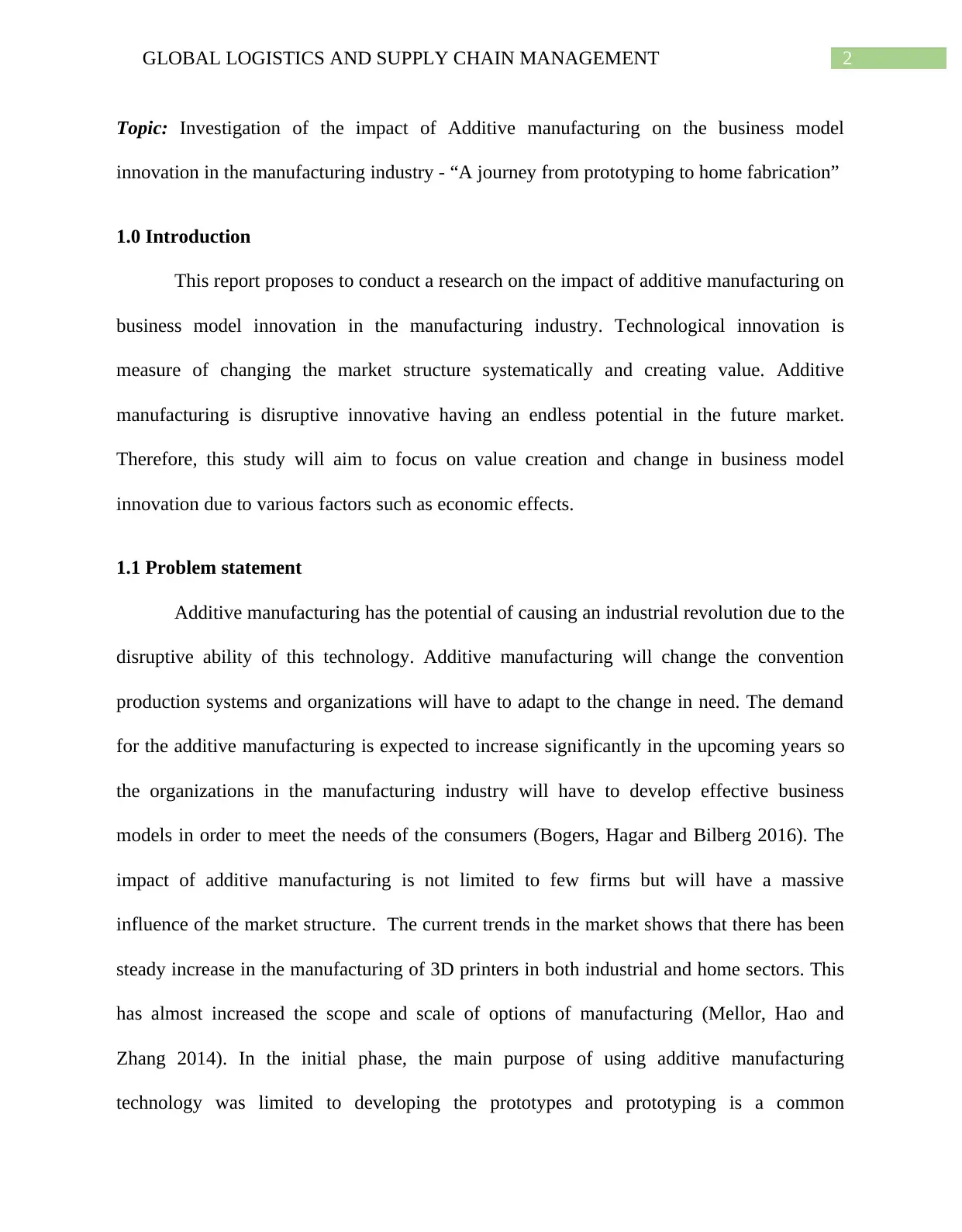
2GLOBAL LOGISTICS AND SUPPLY CHAIN MANAGEMENT
Topic: Investigation of the impact of Additive manufacturing on the business model
innovation in the manufacturing industry - “A journey from prototyping to home fabrication”
1.0 Introduction
This report proposes to conduct a research on the impact of additive manufacturing on
business model innovation in the manufacturing industry. Technological innovation is
measure of changing the market structure systematically and creating value. Additive
manufacturing is disruptive innovative having an endless potential in the future market.
Therefore, this study will aim to focus on value creation and change in business model
innovation due to various factors such as economic effects.
1.1 Problem statement
Additive manufacturing has the potential of causing an industrial revolution due to the
disruptive ability of this technology. Additive manufacturing will change the convention
production systems and organizations will have to adapt to the change in need. The demand
for the additive manufacturing is expected to increase significantly in the upcoming years so
the organizations in the manufacturing industry will have to develop effective business
models in order to meet the needs of the consumers (Bogers, Hagar and Bilberg 2016). The
impact of additive manufacturing is not limited to few firms but will have a massive
influence of the market structure. The current trends in the market shows that there has been
steady increase in the manufacturing of 3D printers in both industrial and home sectors. This
has almost increased the scope and scale of options of manufacturing (Mellor, Hao and
Zhang 2014). In the initial phase, the main purpose of using additive manufacturing
technology was limited to developing the prototypes and prototyping is a common
Topic: Investigation of the impact of Additive manufacturing on the business model
innovation in the manufacturing industry - “A journey from prototyping to home fabrication”
1.0 Introduction
This report proposes to conduct a research on the impact of additive manufacturing on
business model innovation in the manufacturing industry. Technological innovation is
measure of changing the market structure systematically and creating value. Additive
manufacturing is disruptive innovative having an endless potential in the future market.
Therefore, this study will aim to focus on value creation and change in business model
innovation due to various factors such as economic effects.
1.1 Problem statement
Additive manufacturing has the potential of causing an industrial revolution due to the
disruptive ability of this technology. Additive manufacturing will change the convention
production systems and organizations will have to adapt to the change in need. The demand
for the additive manufacturing is expected to increase significantly in the upcoming years so
the organizations in the manufacturing industry will have to develop effective business
models in order to meet the needs of the consumers (Bogers, Hagar and Bilberg 2016). The
impact of additive manufacturing is not limited to few firms but will have a massive
influence of the market structure. The current trends in the market shows that there has been
steady increase in the manufacturing of 3D printers in both industrial and home sectors. This
has almost increased the scope and scale of options of manufacturing (Mellor, Hao and
Zhang 2014). In the initial phase, the main purpose of using additive manufacturing
technology was limited to developing the prototypes and prototyping is a common
⊘ This is a preview!⊘
Do you want full access?
Subscribe today to unlock all pages.

Trusted by 1+ million students worldwide
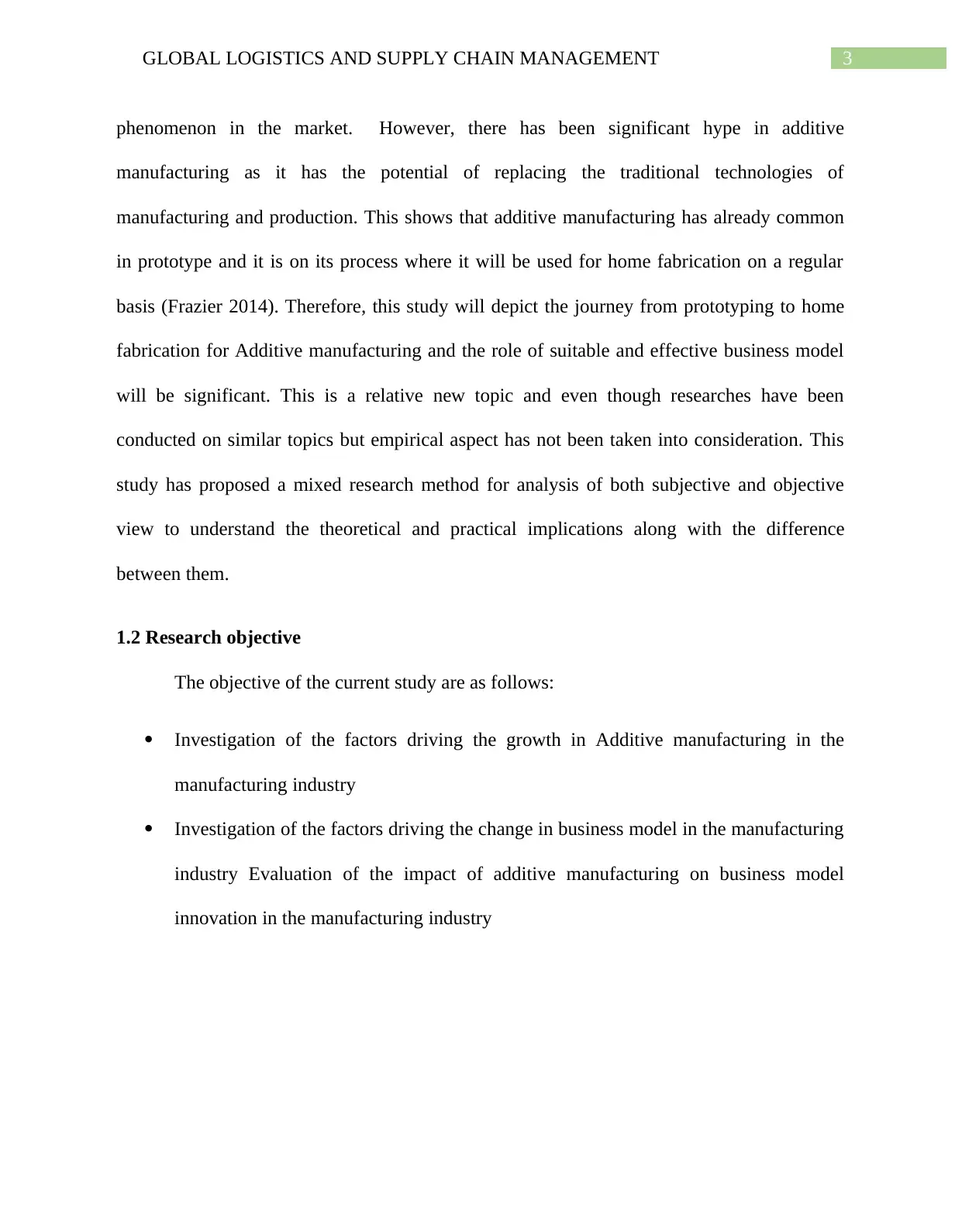
3GLOBAL LOGISTICS AND SUPPLY CHAIN MANAGEMENT
phenomenon in the market. However, there has been significant hype in additive
manufacturing as it has the potential of replacing the traditional technologies of
manufacturing and production. This shows that additive manufacturing has already common
in prototype and it is on its process where it will be used for home fabrication on a regular
basis (Frazier 2014). Therefore, this study will depict the journey from prototyping to home
fabrication for Additive manufacturing and the role of suitable and effective business model
will be significant. This is a relative new topic and even though researches have been
conducted on similar topics but empirical aspect has not been taken into consideration. This
study has proposed a mixed research method for analysis of both subjective and objective
view to understand the theoretical and practical implications along with the difference
between them.
1.2 Research objective
The objective of the current study are as follows:
Investigation of the factors driving the growth in Additive manufacturing in the
manufacturing industry
Investigation of the factors driving the change in business model in the manufacturing
industry Evaluation of the impact of additive manufacturing on business model
innovation in the manufacturing industry
phenomenon in the market. However, there has been significant hype in additive
manufacturing as it has the potential of replacing the traditional technologies of
manufacturing and production. This shows that additive manufacturing has already common
in prototype and it is on its process where it will be used for home fabrication on a regular
basis (Frazier 2014). Therefore, this study will depict the journey from prototyping to home
fabrication for Additive manufacturing and the role of suitable and effective business model
will be significant. This is a relative new topic and even though researches have been
conducted on similar topics but empirical aspect has not been taken into consideration. This
study has proposed a mixed research method for analysis of both subjective and objective
view to understand the theoretical and practical implications along with the difference
between them.
1.2 Research objective
The objective of the current study are as follows:
Investigation of the factors driving the growth in Additive manufacturing in the
manufacturing industry
Investigation of the factors driving the change in business model in the manufacturing
industry Evaluation of the impact of additive manufacturing on business model
innovation in the manufacturing industry
Paraphrase This Document
Need a fresh take? Get an instant paraphrase of this document with our AI Paraphraser
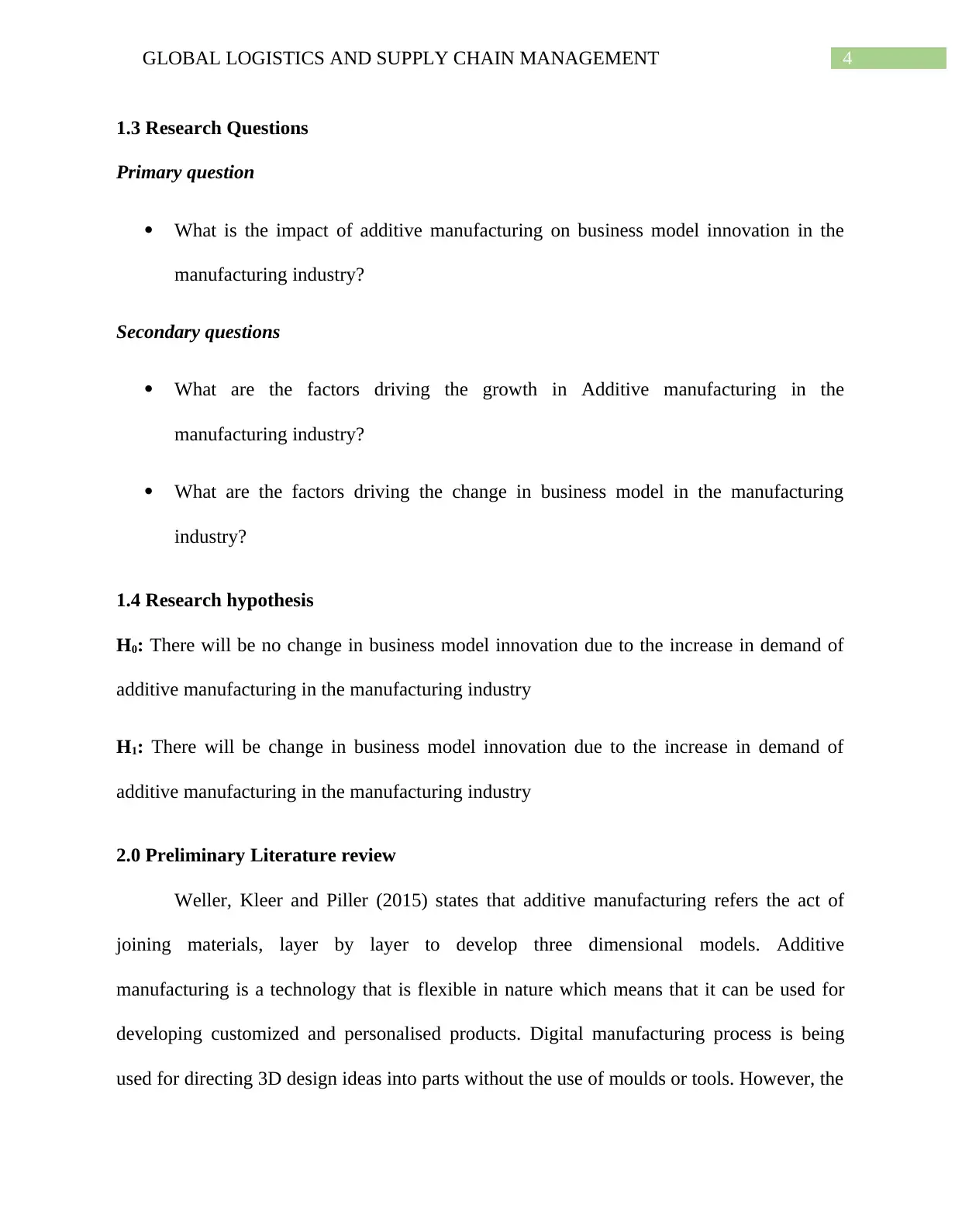
4GLOBAL LOGISTICS AND SUPPLY CHAIN MANAGEMENT
1.3 Research Questions
Primary question
What is the impact of additive manufacturing on business model innovation in the
manufacturing industry?
Secondary questions
What are the factors driving the growth in Additive manufacturing in the
manufacturing industry?
What are the factors driving the change in business model in the manufacturing
industry?
1.4 Research hypothesis
H0: There will be no change in business model innovation due to the increase in demand of
additive manufacturing in the manufacturing industry
H1: There will be change in business model innovation due to the increase in demand of
additive manufacturing in the manufacturing industry
2.0 Preliminary Literature review
Weller, Kleer and Piller (2015) states that additive manufacturing refers the act of
joining materials, layer by layer to develop three dimensional models. Additive
manufacturing is a technology that is flexible in nature which means that it can be used for
developing customized and personalised products. Digital manufacturing process is being
used for directing 3D design ideas into parts without the use of moulds or tools. However, the
1.3 Research Questions
Primary question
What is the impact of additive manufacturing on business model innovation in the
manufacturing industry?
Secondary questions
What are the factors driving the growth in Additive manufacturing in the
manufacturing industry?
What are the factors driving the change in business model in the manufacturing
industry?
1.4 Research hypothesis
H0: There will be no change in business model innovation due to the increase in demand of
additive manufacturing in the manufacturing industry
H1: There will be change in business model innovation due to the increase in demand of
additive manufacturing in the manufacturing industry
2.0 Preliminary Literature review
Weller, Kleer and Piller (2015) states that additive manufacturing refers the act of
joining materials, layer by layer to develop three dimensional models. Additive
manufacturing is a technology that is flexible in nature which means that it can be used for
developing customized and personalised products. Digital manufacturing process is being
used for directing 3D design ideas into parts without the use of moulds or tools. However, the
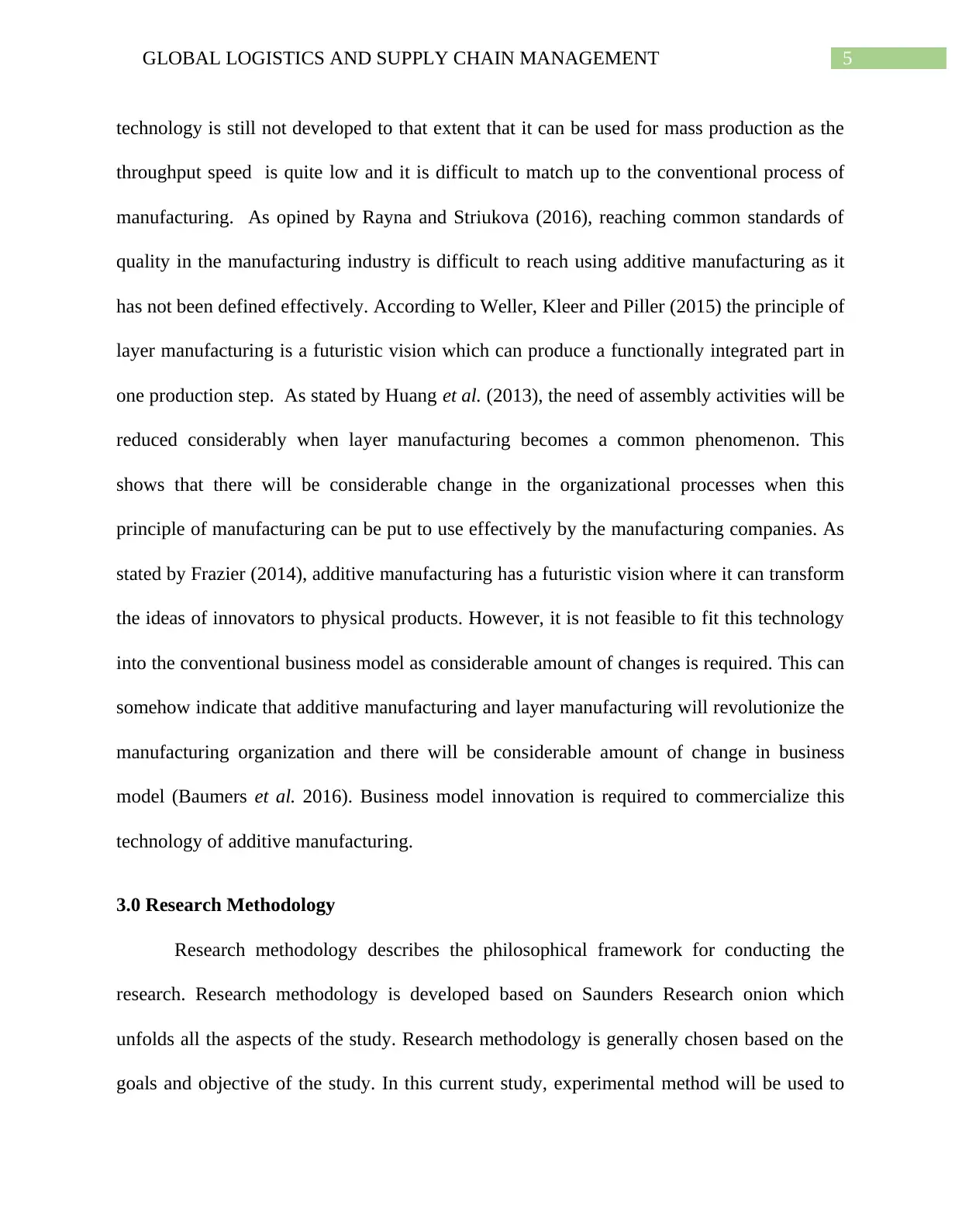
5GLOBAL LOGISTICS AND SUPPLY CHAIN MANAGEMENT
technology is still not developed to that extent that it can be used for mass production as the
throughput speed is quite low and it is difficult to match up to the conventional process of
manufacturing. As opined by Rayna and Striukova (2016), reaching common standards of
quality in the manufacturing industry is difficult to reach using additive manufacturing as it
has not been defined effectively. According to Weller, Kleer and Piller (2015) the principle of
layer manufacturing is a futuristic vision which can produce a functionally integrated part in
one production step. As stated by Huang et al. (2013), the need of assembly activities will be
reduced considerably when layer manufacturing becomes a common phenomenon. This
shows that there will be considerable change in the organizational processes when this
principle of manufacturing can be put to use effectively by the manufacturing companies. As
stated by Frazier (2014), additive manufacturing has a futuristic vision where it can transform
the ideas of innovators to physical products. However, it is not feasible to fit this technology
into the conventional business model as considerable amount of changes is required. This can
somehow indicate that additive manufacturing and layer manufacturing will revolutionize the
manufacturing organization and there will be considerable amount of change in business
model (Baumers et al. 2016). Business model innovation is required to commercialize this
technology of additive manufacturing.
3.0 Research Methodology
Research methodology describes the philosophical framework for conducting the
research. Research methodology is developed based on Saunders Research onion which
unfolds all the aspects of the study. Research methodology is generally chosen based on the
goals and objective of the study. In this current study, experimental method will be used to
technology is still not developed to that extent that it can be used for mass production as the
throughput speed is quite low and it is difficult to match up to the conventional process of
manufacturing. As opined by Rayna and Striukova (2016), reaching common standards of
quality in the manufacturing industry is difficult to reach using additive manufacturing as it
has not been defined effectively. According to Weller, Kleer and Piller (2015) the principle of
layer manufacturing is a futuristic vision which can produce a functionally integrated part in
one production step. As stated by Huang et al. (2013), the need of assembly activities will be
reduced considerably when layer manufacturing becomes a common phenomenon. This
shows that there will be considerable change in the organizational processes when this
principle of manufacturing can be put to use effectively by the manufacturing companies. As
stated by Frazier (2014), additive manufacturing has a futuristic vision where it can transform
the ideas of innovators to physical products. However, it is not feasible to fit this technology
into the conventional business model as considerable amount of changes is required. This can
somehow indicate that additive manufacturing and layer manufacturing will revolutionize the
manufacturing organization and there will be considerable amount of change in business
model (Baumers et al. 2016). Business model innovation is required to commercialize this
technology of additive manufacturing.
3.0 Research Methodology
Research methodology describes the philosophical framework for conducting the
research. Research methodology is developed based on Saunders Research onion which
unfolds all the aspects of the study. Research methodology is generally chosen based on the
goals and objective of the study. In this current study, experimental method will be used to
⊘ This is a preview!⊘
Do you want full access?
Subscribe today to unlock all pages.

Trusted by 1+ million students worldwide
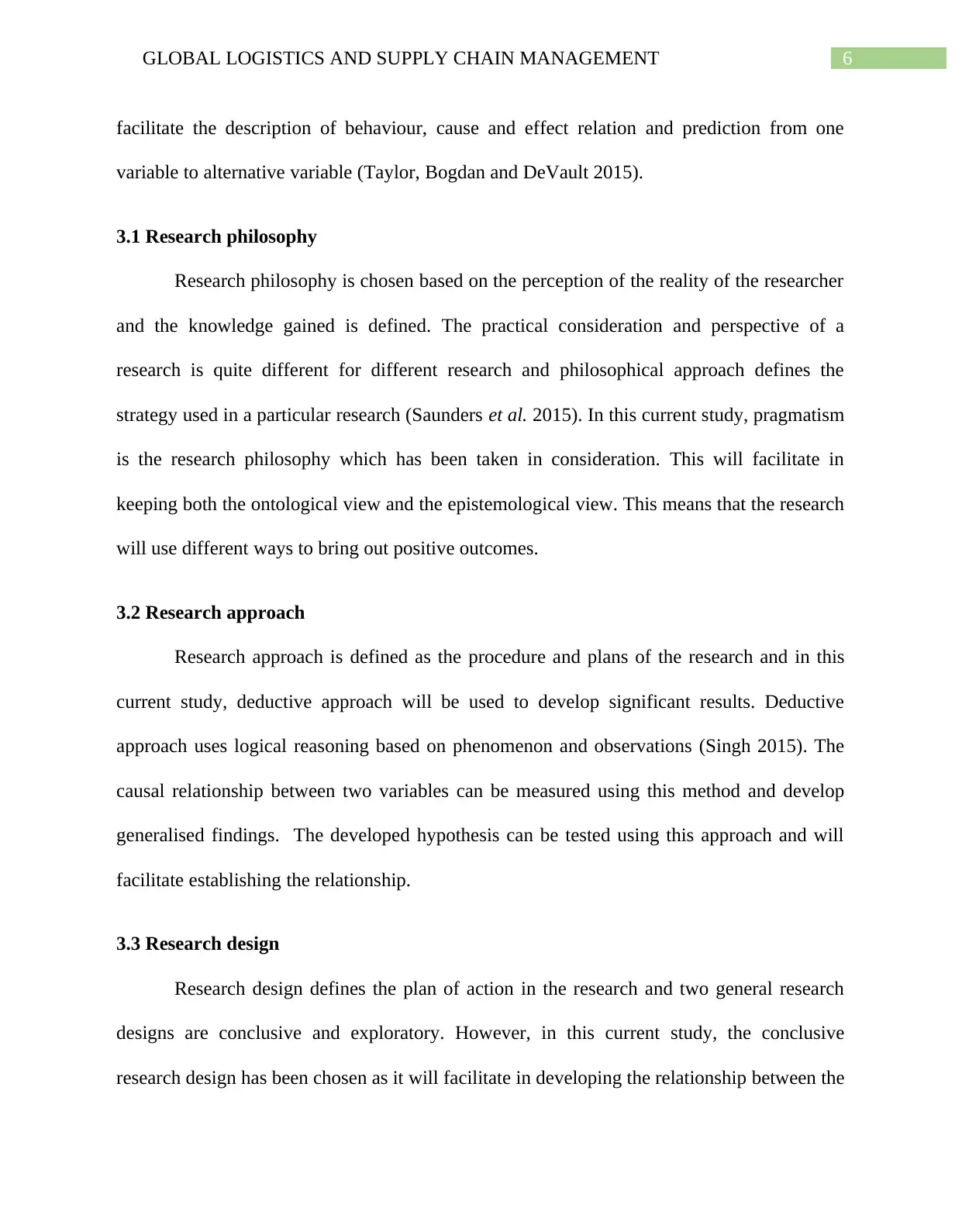
6GLOBAL LOGISTICS AND SUPPLY CHAIN MANAGEMENT
facilitate the description of behaviour, cause and effect relation and prediction from one
variable to alternative variable (Taylor, Bogdan and DeVault 2015).
3.1 Research philosophy
Research philosophy is chosen based on the perception of the reality of the researcher
and the knowledge gained is defined. The practical consideration and perspective of a
research is quite different for different research and philosophical approach defines the
strategy used in a particular research (Saunders et al. 2015). In this current study, pragmatism
is the research philosophy which has been taken in consideration. This will facilitate in
keeping both the ontological view and the epistemological view. This means that the research
will use different ways to bring out positive outcomes.
3.2 Research approach
Research approach is defined as the procedure and plans of the research and in this
current study, deductive approach will be used to develop significant results. Deductive
approach uses logical reasoning based on phenomenon and observations (Singh 2015). The
causal relationship between two variables can be measured using this method and develop
generalised findings. The developed hypothesis can be tested using this approach and will
facilitate establishing the relationship.
3.3 Research design
Research design defines the plan of action in the research and two general research
designs are conclusive and exploratory. However, in this current study, the conclusive
research design has been chosen as it will facilitate in developing the relationship between the
facilitate the description of behaviour, cause and effect relation and prediction from one
variable to alternative variable (Taylor, Bogdan and DeVault 2015).
3.1 Research philosophy
Research philosophy is chosen based on the perception of the reality of the researcher
and the knowledge gained is defined. The practical consideration and perspective of a
research is quite different for different research and philosophical approach defines the
strategy used in a particular research (Saunders et al. 2015). In this current study, pragmatism
is the research philosophy which has been taken in consideration. This will facilitate in
keeping both the ontological view and the epistemological view. This means that the research
will use different ways to bring out positive outcomes.
3.2 Research approach
Research approach is defined as the procedure and plans of the research and in this
current study, deductive approach will be used to develop significant results. Deductive
approach uses logical reasoning based on phenomenon and observations (Singh 2015). The
causal relationship between two variables can be measured using this method and develop
generalised findings. The developed hypothesis can be tested using this approach and will
facilitate establishing the relationship.
3.3 Research design
Research design defines the plan of action in the research and two general research
designs are conclusive and exploratory. However, in this current study, the conclusive
research design has been chosen as it will facilitate in developing the relationship between the
Paraphrase This Document
Need a fresh take? Get an instant paraphrase of this document with our AI Paraphraser
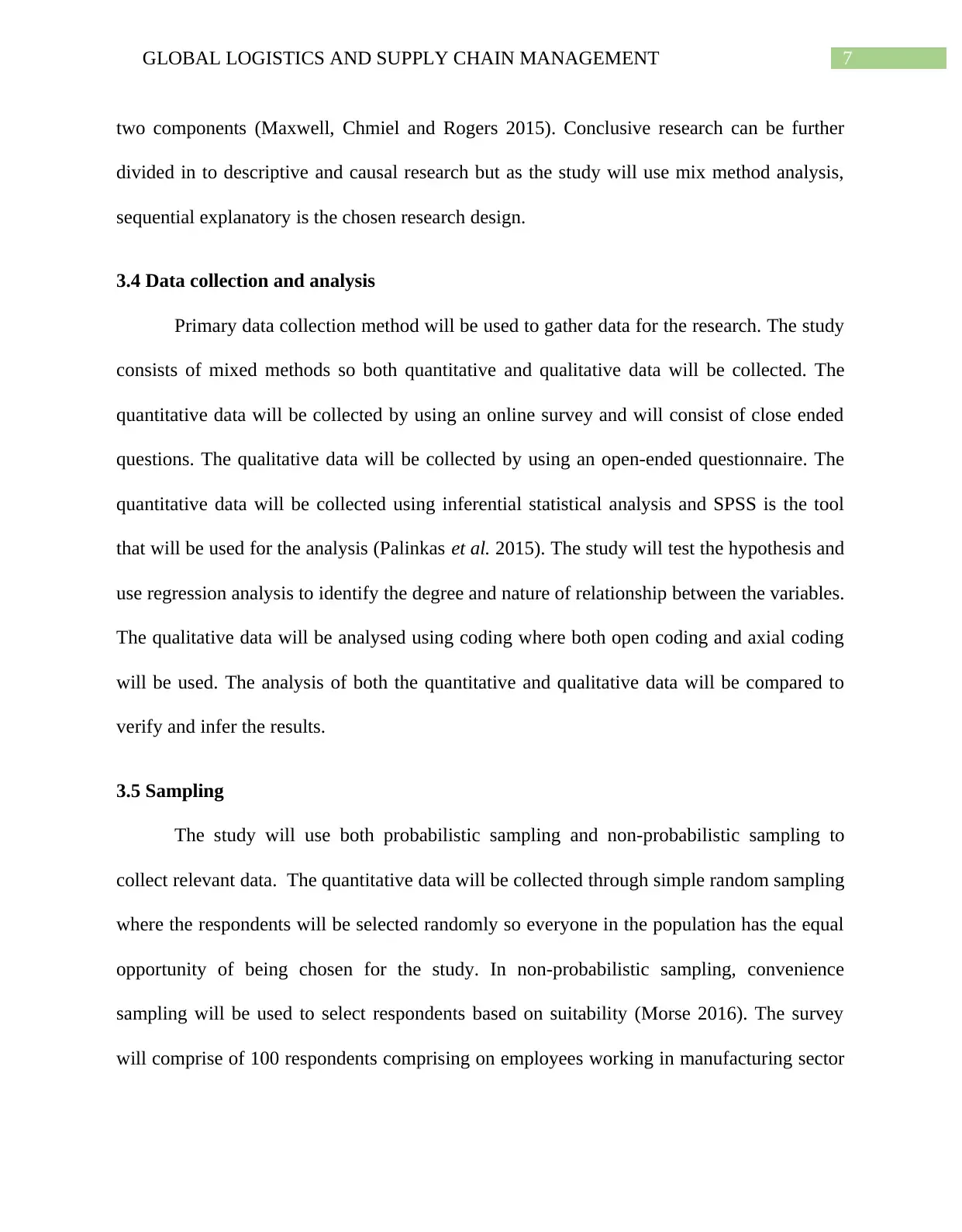
7GLOBAL LOGISTICS AND SUPPLY CHAIN MANAGEMENT
two components (Maxwell, Chmiel and Rogers 2015). Conclusive research can be further
divided in to descriptive and causal research but as the study will use mix method analysis,
sequential explanatory is the chosen research design.
3.4 Data collection and analysis
Primary data collection method will be used to gather data for the research. The study
consists of mixed methods so both quantitative and qualitative data will be collected. The
quantitative data will be collected by using an online survey and will consist of close ended
questions. The qualitative data will be collected by using an open-ended questionnaire. The
quantitative data will be collected using inferential statistical analysis and SPSS is the tool
that will be used for the analysis (Palinkas et al. 2015). The study will test the hypothesis and
use regression analysis to identify the degree and nature of relationship between the variables.
The qualitative data will be analysed using coding where both open coding and axial coding
will be used. The analysis of both the quantitative and qualitative data will be compared to
verify and infer the results.
3.5 Sampling
The study will use both probabilistic sampling and non-probabilistic sampling to
collect relevant data. The quantitative data will be collected through simple random sampling
where the respondents will be selected randomly so everyone in the population has the equal
opportunity of being chosen for the study. In non-probabilistic sampling, convenience
sampling will be used to select respondents based on suitability (Morse 2016). The survey
will comprise of 100 respondents comprising on employees working in manufacturing sector
two components (Maxwell, Chmiel and Rogers 2015). Conclusive research can be further
divided in to descriptive and causal research but as the study will use mix method analysis,
sequential explanatory is the chosen research design.
3.4 Data collection and analysis
Primary data collection method will be used to gather data for the research. The study
consists of mixed methods so both quantitative and qualitative data will be collected. The
quantitative data will be collected by using an online survey and will consist of close ended
questions. The qualitative data will be collected by using an open-ended questionnaire. The
quantitative data will be collected using inferential statistical analysis and SPSS is the tool
that will be used for the analysis (Palinkas et al. 2015). The study will test the hypothesis and
use regression analysis to identify the degree and nature of relationship between the variables.
The qualitative data will be analysed using coding where both open coding and axial coding
will be used. The analysis of both the quantitative and qualitative data will be compared to
verify and infer the results.
3.5 Sampling
The study will use both probabilistic sampling and non-probabilistic sampling to
collect relevant data. The quantitative data will be collected through simple random sampling
where the respondents will be selected randomly so everyone in the population has the equal
opportunity of being chosen for the study. In non-probabilistic sampling, convenience
sampling will be used to select respondents based on suitability (Morse 2016). The survey
will comprise of 100 respondents comprising on employees working in manufacturing sector
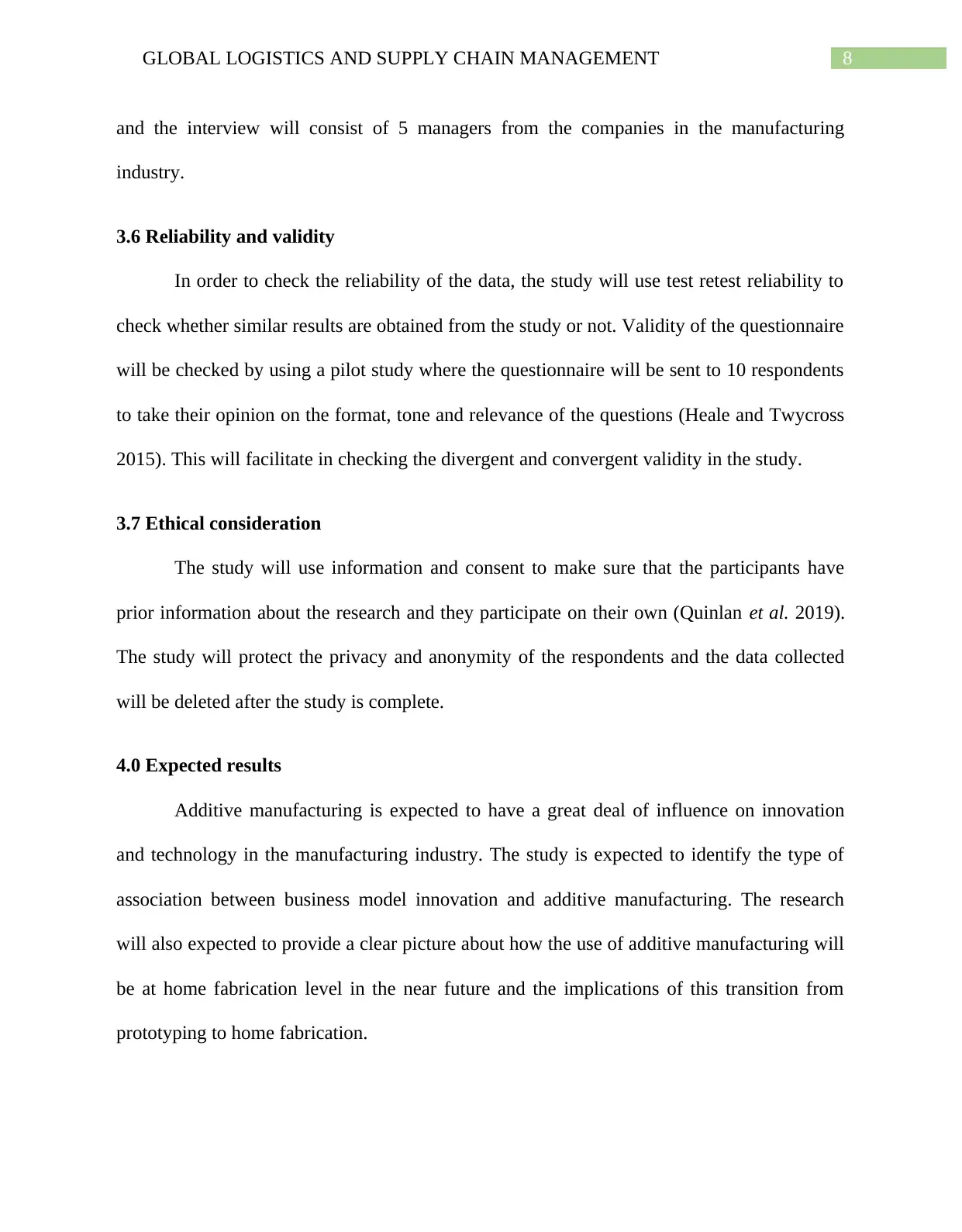
8GLOBAL LOGISTICS AND SUPPLY CHAIN MANAGEMENT
and the interview will consist of 5 managers from the companies in the manufacturing
industry.
3.6 Reliability and validity
In order to check the reliability of the data, the study will use test retest reliability to
check whether similar results are obtained from the study or not. Validity of the questionnaire
will be checked by using a pilot study where the questionnaire will be sent to 10 respondents
to take their opinion on the format, tone and relevance of the questions (Heale and Twycross
2015). This will facilitate in checking the divergent and convergent validity in the study.
3.7 Ethical consideration
The study will use information and consent to make sure that the participants have
prior information about the research and they participate on their own (Quinlan et al. 2019).
The study will protect the privacy and anonymity of the respondents and the data collected
will be deleted after the study is complete.
4.0 Expected results
Additive manufacturing is expected to have a great deal of influence on innovation
and technology in the manufacturing industry. The study is expected to identify the type of
association between business model innovation and additive manufacturing. The research
will also expected to provide a clear picture about how the use of additive manufacturing will
be at home fabrication level in the near future and the implications of this transition from
prototyping to home fabrication.
and the interview will consist of 5 managers from the companies in the manufacturing
industry.
3.6 Reliability and validity
In order to check the reliability of the data, the study will use test retest reliability to
check whether similar results are obtained from the study or not. Validity of the questionnaire
will be checked by using a pilot study where the questionnaire will be sent to 10 respondents
to take their opinion on the format, tone and relevance of the questions (Heale and Twycross
2015). This will facilitate in checking the divergent and convergent validity in the study.
3.7 Ethical consideration
The study will use information and consent to make sure that the participants have
prior information about the research and they participate on their own (Quinlan et al. 2019).
The study will protect the privacy and anonymity of the respondents and the data collected
will be deleted after the study is complete.
4.0 Expected results
Additive manufacturing is expected to have a great deal of influence on innovation
and technology in the manufacturing industry. The study is expected to identify the type of
association between business model innovation and additive manufacturing. The research
will also expected to provide a clear picture about how the use of additive manufacturing will
be at home fabrication level in the near future and the implications of this transition from
prototyping to home fabrication.
⊘ This is a preview!⊘
Do you want full access?
Subscribe today to unlock all pages.

Trusted by 1+ million students worldwide
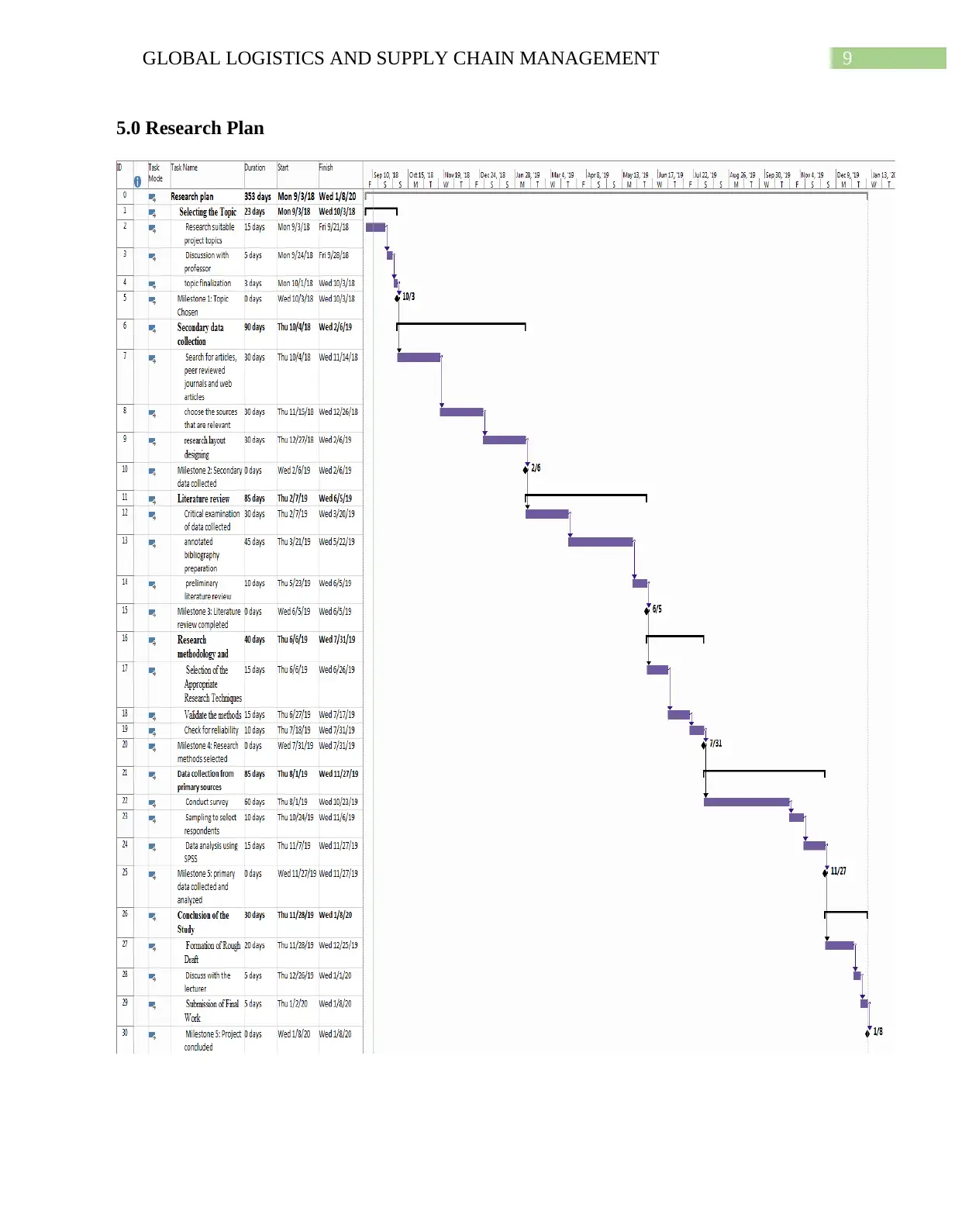
9GLOBAL LOGISTICS AND SUPPLY CHAIN MANAGEMENT
5.0 Research Plan
5.0 Research Plan
Paraphrase This Document
Need a fresh take? Get an instant paraphrase of this document with our AI Paraphraser
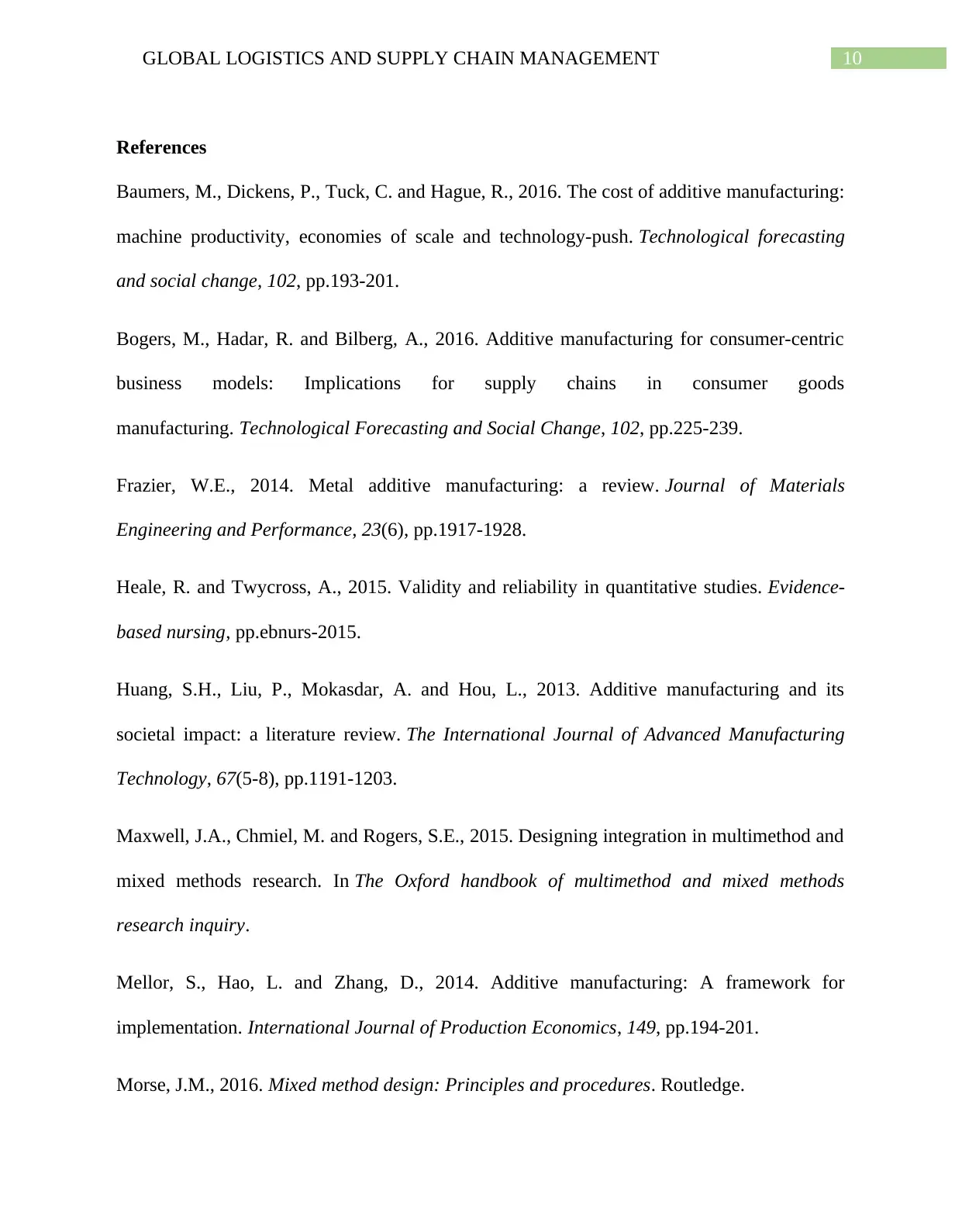
10GLOBAL LOGISTICS AND SUPPLY CHAIN MANAGEMENT
References
Baumers, M., Dickens, P., Tuck, C. and Hague, R., 2016. The cost of additive manufacturing:
machine productivity, economies of scale and technology-push. Technological forecasting
and social change, 102, pp.193-201.
Bogers, M., Hadar, R. and Bilberg, A., 2016. Additive manufacturing for consumer-centric
business models: Implications for supply chains in consumer goods
manufacturing. Technological Forecasting and Social Change, 102, pp.225-239.
Frazier, W.E., 2014. Metal additive manufacturing: a review. Journal of Materials
Engineering and Performance, 23(6), pp.1917-1928.
Heale, R. and Twycross, A., 2015. Validity and reliability in quantitative studies. Evidence-
based nursing, pp.ebnurs-2015.
Huang, S.H., Liu, P., Mokasdar, A. and Hou, L., 2013. Additive manufacturing and its
societal impact: a literature review. The International Journal of Advanced Manufacturing
Technology, 67(5-8), pp.1191-1203.
Maxwell, J.A., Chmiel, M. and Rogers, S.E., 2015. Designing integration in multimethod and
mixed methods research. In The Oxford handbook of multimethod and mixed methods
research inquiry.
Mellor, S., Hao, L. and Zhang, D., 2014. Additive manufacturing: A framework for
implementation. International Journal of Production Economics, 149, pp.194-201.
Morse, J.M., 2016. Mixed method design: Principles and procedures. Routledge.
References
Baumers, M., Dickens, P., Tuck, C. and Hague, R., 2016. The cost of additive manufacturing:
machine productivity, economies of scale and technology-push. Technological forecasting
and social change, 102, pp.193-201.
Bogers, M., Hadar, R. and Bilberg, A., 2016. Additive manufacturing for consumer-centric
business models: Implications for supply chains in consumer goods
manufacturing. Technological Forecasting and Social Change, 102, pp.225-239.
Frazier, W.E., 2014. Metal additive manufacturing: a review. Journal of Materials
Engineering and Performance, 23(6), pp.1917-1928.
Heale, R. and Twycross, A., 2015. Validity and reliability in quantitative studies. Evidence-
based nursing, pp.ebnurs-2015.
Huang, S.H., Liu, P., Mokasdar, A. and Hou, L., 2013. Additive manufacturing and its
societal impact: a literature review. The International Journal of Advanced Manufacturing
Technology, 67(5-8), pp.1191-1203.
Maxwell, J.A., Chmiel, M. and Rogers, S.E., 2015. Designing integration in multimethod and
mixed methods research. In The Oxford handbook of multimethod and mixed methods
research inquiry.
Mellor, S., Hao, L. and Zhang, D., 2014. Additive manufacturing: A framework for
implementation. International Journal of Production Economics, 149, pp.194-201.
Morse, J.M., 2016. Mixed method design: Principles and procedures. Routledge.

11GLOBAL LOGISTICS AND SUPPLY CHAIN MANAGEMENT
Palinkas, L.A., Horwitz, S.M., Green, C.A., Wisdom, J.P., Duan, N. and Hoagwood, K.,
2015. Purposeful sampling for qualitative data collection and analysis in mixed method
implementation research. Administration and Policy in Mental Health and Mental Health
Services Research, 42(5), pp.533-544.
Quinlan, C., Babin, B., Carr, J. and Griffin, M., 2019. Business research methods. South
Western Cengage.
Rayna, T. and Striukova, L., 2016. From rapid prototyping to home fabrication: How 3D
printing is changing business model innovation. Technological Forecasting and Social
Change, 102, pp.214-224.
Saunders, M.N., Lewis, P., Thornhill, A. and Bristow, A., 2015. Understanding research
philosophy and approaches to theory development.
Singh, K.D., 2015. Creating your own qualitative research approach: Selecting, integrating
and operationalizing philosophy, methodology and methods. Vision, 19(2), pp.132-146.
Taylor, S.J., Bogdan, R. and DeVault, M., 2015. Introduction to qualitative research
methods: A guidebook and resource. John Wiley & Sons.
Weller, C., Kleer, R. and Piller, F.T., 2015. Economic implications of 3D printing: Market
structure models in light of additive manufacturing revisited. International Journal of
Production Economics, 164, pp.43-56.
Palinkas, L.A., Horwitz, S.M., Green, C.A., Wisdom, J.P., Duan, N. and Hoagwood, K.,
2015. Purposeful sampling for qualitative data collection and analysis in mixed method
implementation research. Administration and Policy in Mental Health and Mental Health
Services Research, 42(5), pp.533-544.
Quinlan, C., Babin, B., Carr, J. and Griffin, M., 2019. Business research methods. South
Western Cengage.
Rayna, T. and Striukova, L., 2016. From rapid prototyping to home fabrication: How 3D
printing is changing business model innovation. Technological Forecasting and Social
Change, 102, pp.214-224.
Saunders, M.N., Lewis, P., Thornhill, A. and Bristow, A., 2015. Understanding research
philosophy and approaches to theory development.
Singh, K.D., 2015. Creating your own qualitative research approach: Selecting, integrating
and operationalizing philosophy, methodology and methods. Vision, 19(2), pp.132-146.
Taylor, S.J., Bogdan, R. and DeVault, M., 2015. Introduction to qualitative research
methods: A guidebook and resource. John Wiley & Sons.
Weller, C., Kleer, R. and Piller, F.T., 2015. Economic implications of 3D printing: Market
structure models in light of additive manufacturing revisited. International Journal of
Production Economics, 164, pp.43-56.
⊘ This is a preview!⊘
Do you want full access?
Subscribe today to unlock all pages.

Trusted by 1+ million students worldwide
1 out of 12
Related Documents
Your All-in-One AI-Powered Toolkit for Academic Success.
+13062052269
info@desklib.com
Available 24*7 on WhatsApp / Email
![[object Object]](/_next/static/media/star-bottom.7253800d.svg)
Unlock your academic potential
Copyright © 2020–2025 A2Z Services. All Rights Reserved. Developed and managed by ZUCOL.





